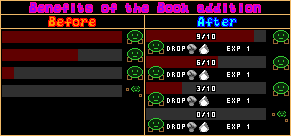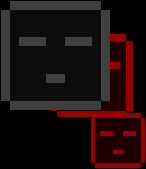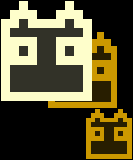
The Castle Boss is one of the most dangerous bosses in the game, featuring fire projectiles and a powerful red Two Arrow attack.
Enemies are creatures or monsters present in Stick Ranger. They are a vital part of the game, because the game revolves around killing enemies.
There are a multitude of enemies in the game, and they have varying levels of difficulty. Generally, the deeper into the game an enemy is found, the harder the enemy is. Each enemy unit has one or two different types of attacks, as well as an LP value that determines its health (see below). When an enemy is damaged, its health is momentarily displayed as a red bar on the top of the game screen. Once the enemy's LP is reduced to 0, it will die, shattering into little bits, as well as possibly releasing any items it is carrying. In addition the player gets a certain amount of experience, which depends on the enemy and the player level.
Most of the enemies are not too difficult to handle, except for a few of them. These enemies are known as bosses. These enemies reside at the end of a stage, and they usually have more LP, as well as do more damage than other enemies found in the same stage.
Enemies are categorized into species based on their looks and movement. Species have their unique features, usually not found in other species. Enemies can also be classified by their heads. Species and heads form part of the naming system of enemies, as explained in detail further below.
Enemy bounty[]
This is a list of things that enemies may drop/give upon death:
- EXP is given upon slaying any enemy.
- Items: When dropped, it will jump in an arc (adjustable by the pointer's location) and blink. The item becomes collectible once it stops blinking.
- Weapons are dropped only by one or a few types of enemies with a specific drop rate.
- Compo items are dropped only by one or a few specific types of enemies with a specific drop rate.
- Gold is dropped by any type of enemy with a drop rate of 33.3% (equal to one third).
- Onigiri are dropped by any type of enemy with a drop rate of 20%.
Varying amounts of gold are given, depending on the enemy. Since all enemies drop onigiri, it will not be listed in the enemy page, unless the drop rates for onigiri are different or unless the enemy has the potential to drop more than one onigiri, like for instance Big enemies.
EXP, gold and onigiris are dropped/given by all types of enemies. In contrast to this specific weapons and compo items are not dropped by all enemies, rather, specific types enemies are programmed to drop one or two specific item(s).
Increasing bounty[]
Players are able to increase the amount or frequency of bounty from enemies through attaching medals to their characters' weapons.
A character can also use the ONIGIRI's Card or the Gold rush Card to get additional Onigiris/Gold for hitting the enemy, even before it is killed.
Enemy LP[]

This shows the LP of a Green Smiley Walker being reduced. Also shows the results before buying the OS's page in the book and after the purchase.
LP is an important part of an enemy, as it determines the amount of hits it can take before dying. All similar enemies have identical amounts of LP (eg. all Green Smiley Walkers in Opening Street have 10 LP). When an enemy is hit, its Life Bar is shown at the top of the screen, with the red portion being the fraction of its remaining health. Its remaining LP, its drops and the EXP the player gains when it's killed is also shown if the correspondent book is bought. When multiple enemies are hit, only the most recent enemy to take a hit will have its Life Bar displayed. If no enemy is attacked in a period of time, the Life Bar will vanish.
Enemy Naming System[]
Enemies in the game have no official names, and are only represented by their images within the game (this includes the Book). Due to the vast variety of enemies in the game, it is imperative that a structured naming system is established and followed throughout the wiki. We have devised a naming system that classifies all enemies, as shown below:
There are a total of 11129 enemies spreading 330 unique combinations.
| Head | |||||||||||||||||||||||||||||||||||||||
|---|---|---|---|---|---|---|---|---|---|---|---|---|---|---|---|---|---|---|---|---|---|---|---|---|---|---|---|---|---|---|---|---|---|---|---|---|---|---|---|
| Smiley (neutral) |
Smiley (happy) |
X | Skull | Fairy | Cap | Roundhead (neutral) |
Roundhead (inverted) |
Gel | Star | Mask | Box (normal) |
Box (sleepy) |
Box (surprised) |
Diamond | Vampire | Shield | Castle | Demon | Coconut | Triangle | |||||||||||||||||||
| Species | Walkers |
|
|
|
|
|
| ||||||||||||||||||||||||||||||||
| Snakes |
|
|
|
|
|
|
|
| |||||||||||||||||||||||||||||||
| Bats |
|
|
|||||||||||||||||||||||||||||||||||||
| Dragons |
|
|
|||||||||||||||||||||||||||||||||||||
| Trees |
|
|
|
|
|
|
|
|
| ||||||||||||||||||||||||||||||
| Wheels |
|
||||||||||||||||||||||||||||||||||||||
| Fish |
|
|
|
||||||||||||||||||||||||||||||||||||
| Stickmen |
|
|
|
|
|||||||||||||||||||||||||||||||||||
| Mushrooms |
|
|
|
||||||||||||||||||||||||||||||||||||
| Eels |
|
|
|
|
|||||||||||||||||||||||||||||||||||
| Spiders |
|
|
|
||||||||||||||||||||||||||||||||||||
| Cacti |
|
||||||||||||||||||||||||||||||||||||||
| Zombies |
|
|
|||||||||||||||||||||||||||||||||||||
| Copters |
|
||||||||||||||||||||||||||||||||||||||
| Bouncers |
|
||||||||||||||||||||||||||||||||||||||
| Germs |
|
|
|||||||||||||||||||||||||||||||||||||
| Diggers | |||||||||||||||||||||||||||||||||||||||
Note: blank cells denote that no such head-species combination exists.
The colour of the enemy's head will always be the first word in the enemy's name, followed by its head, then by its species. If an enemy is a boss or is big, the word "Boss" or "Big" will be inserted between the color and the head respectively. Mega bosses follow a simpler pattern: adding boss to the end of their stage name. This system produces 3 word names for all enemies, except for big enemies or bosses, with 4 words. Note that there is no distinction between "sad" smileys and "happy" smileys, "normal" boxes and "sleepy" boxes or "normal" roundheads and "inverted" roundheads in the naming system.
In the event that there exist two enemies with identical or similar appearances (eg. Grey Smiley Tree), the stage where the enemy is found is appended at the end of the name in parentheses to distinguish both enemies. Hell 5 is an exception, as three enemies within the stage are similar. To ease this, the enemies there are appended with its attack type in parentheses at the end of its name.
[]
- For a list of all enemies, see Category:Stick Ranger enemies.
- For a list of all species, see Category:Stick Ranger species.
- For a list of all heads, see Category:Stick Ranger heads.
- For a list of all bosses, see Boss.
- For a list of all mega bosses, see Mega boss.
- For a list of all attacks, see Attack (enemy).
- For a sorted list of all enemies, see List of enemies.

















